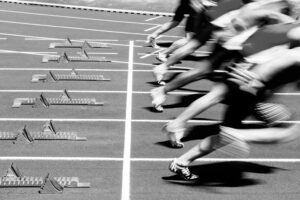A common question around the office for many years has been “Should I eat two or five meals per day?”. Well, the answer is “It depends.”
 Historically, it used to be that a high meal frequency was the gold-standard. Then, intermittent fasting took the world by storm and eating less frequently became popular. The true answer of how many meals to eat comes down to your individual situation. Every person is different and there may be certain situations that diverge from any one universal recommendation.
Historically, it used to be that a high meal frequency was the gold-standard. Then, intermittent fasting took the world by storm and eating less frequently became popular. The true answer of how many meals to eat comes down to your individual situation. Every person is different and there may be certain situations that diverge from any one universal recommendation.
How many meals you should eat will depend on your body composition, preferences, and goals. If you are a regular person with a day job who is trying to lose body fat or simply maintain your current physique, fewer meals are generally better.
Benefits of Fewer Meals
There are surprising benefits to limiting your meal frequency to three or fewer a day. Fewer meals gives your GI tract a chance to rest, which is important for gut motility. Gut motility occurs once digestion is finished and muscles of the GI tract stretch and contract. This enables food to progress through the intestines and ensure absorption of nutrients.
Fewer meals can also be better for metabolic health. When you eat frequent meals, blood sugar and insulin stay elevated, never allowing the body to shift into fat burning mode. This may have the side effect of stimulating hunger anytime glucose levels drop, leading to a higher total calorie intake. Eating fewer meals is a simple way to reduce your daily caloric intake. It is also just a good exercise in mental discipline and provides intentionality in what and when you are consuming foods.
Eating fewer meals in the day has been shown to have a wide variety of benefits:
Improved fat burning and greater use of ketones. Healthier profile of gut bacteria that is associated with leanness. Protection against fat gain when your diet isn’t ideal. Support for circadian function and organ health. Improved sleep and cognitive health, including better memory and learning.
How to Eat Fewer Meals
Fasting involves periods without food or calories, which allows your body to burn stored fat, carbs, and proteins for energy. After an overnight fast, your body relies  on liver glycogen to give you energy. One popular way to eat fewer meals is to skip breakfast and keep fasting. Those glycogen stores will be depleted and as glycogen stores fall, fat burning increases and the body burns ketones and glycerol for energy.
on liver glycogen to give you energy. One popular way to eat fewer meals is to skip breakfast and keep fasting. Those glycogen stores will be depleted and as glycogen stores fall, fat burning increases and the body burns ketones and glycerol for energy.
Time restricted fasting or intermittent fasting generally involves limiting your intake of food to a 6-8 hour window in the day and fasting the rest of the day and night. The limited time spent consuming food necessitates the need for healthy nutrients during this time period. Drinking water with electrolytes is recommended during fasting. Maintaining hydration is important to regulate the circulatory and lymphatic system, both of which are involved in the body’s waste removal system.
Avoid consuming soda, alcohol, caloric beverages, refined foods, and added sugar foods when your intermittent fasting. Because fasting is by nature stressful, consuming inflammatory foods like these when you have been fasting only increases their destructive damage. Instead focus on eating foods dense in macronutrients. Proportions should be individualized but general recommendations with fasting are for a balanced approach that gets 40 percent of calories from carbs, 30 percent from fat, and 30 percent from protein. Higher carb and higher fat approaches can be used but not at the expense of protein, which is crucial for maintaining lean mass. An intake of 1.6 g/kg of body weight a day is recommended.
If you find yourself wanting to experiment with longer fasting periods the macronutrient ratios may be altered. Typically, the longer your fasting period becomes the more fat and protein will need to be consumed. These foods can provide energy for a much longer time period to keep the body healthy and less stressed during the fasting period. At this same time more strenuous workouts should also be avoided in favor of more relaxing exercise like walking or yoga.
The Drawbacks of Frequent Meals
Frequent eating appears to increase hunger and desire to eat, leading to an overall higher energy intake. That’s why eating every 3 hours is a bad choice for fat loss, but it’s just the ticket when you want to pack on muscle.
 High frequency eating also impairs circadian rhythm (your internal body clock), leading to altered levels of hormones involved in hunger and satisfaction. It can also be harmful to metabolic organs such as the liver and pancreas. Both play critical roles in your body’s ability to burn fat and glucose. Frequent eating can also lead to fat deposition in the liver.
High frequency eating also impairs circadian rhythm (your internal body clock), leading to altered levels of hormones involved in hunger and satisfaction. It can also be harmful to metabolic organs such as the liver and pancreas. Both play critical roles in your body’s ability to burn fat and glucose. Frequent eating can also lead to fat deposition in the liver.
Another problem with a higher meal frequency is that people are surprisingly bad at portion control and tend to significantly underestimate the number of calories they are eating. Surveys show that even when people are actively counting calories, they underreport what they eat by an average of 47 percent.
For every eating opportunity, you have a chance of overshooting calorie needs. By reducing your “eating opportunities,” you have fewer chances to overeat calories, which will pay off in better weight management or fat loss.
What about athletes?
 For the average general population, aiming for two to three solid meals each day will be sufficient. But, the advanced athlete intent on training hard or adding muscle will need to have a different plan. Athletes should look to eat four to five times a day to not only intake the number of calories required but to also limit the amount of time the body is feeling stressed from fasting.
For the average general population, aiming for two to three solid meals each day will be sufficient. But, the advanced athlete intent on training hard or adding muscle will need to have a different plan. Athletes should look to eat four to five times a day to not only intake the number of calories required but to also limit the amount of time the body is feeling stressed from fasting.
Serious athletes need a higher dose of basic raw materials from calories, macronutrients, and micronutrients for recovery. Their increased caloric output and oxidative damage from their training necessitates frequent feeding times to repair and recover from the training demands. Adding some smaller feeding meals through the day can lead to success. When compared to the general population who are looking to lose weight with fasting the athlete should aim for a higher ratio of carbohydrates and protein. Two things that are greatly depleted with exercise. On training days, add an amino acid supplement pre-workout and a protein shake after training to support recovery.
Conclusion
 In life, timing is everything. This holds true when it comes to eating: Research shows that by carefully planning when and what you eat, it’s possible to lose fat, improve body composition, and encourage better overall health. It is our goal at [Core] to partner with you to reach your health goals. Our desire is to see you become healthier than you have ever been!
In life, timing is everything. This holds true when it comes to eating: Research shows that by carefully planning when and what you eat, it’s possible to lose fat, improve body composition, and encourage better overall health. It is our goal at [Core] to partner with you to reach your health goals. Our desire is to see you become healthier than you have ever been!
[Core] Chiropractic and Wellness
CoreRoanoke.com







